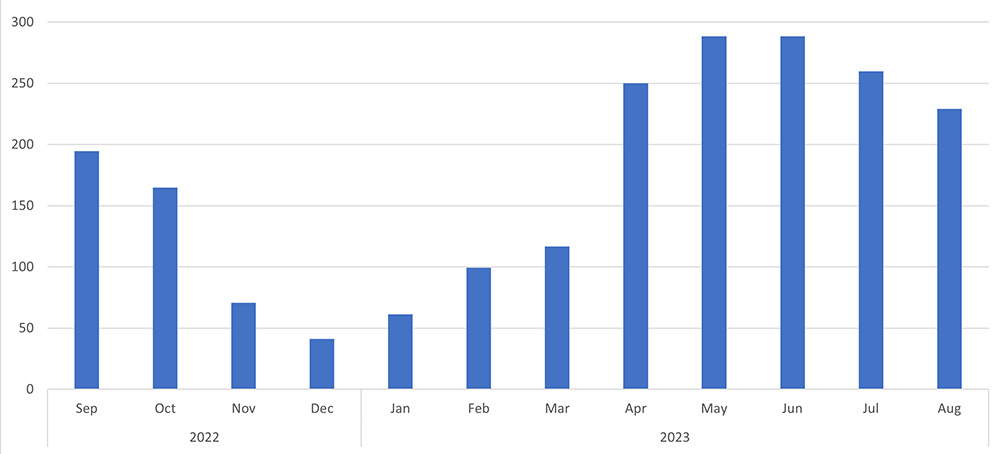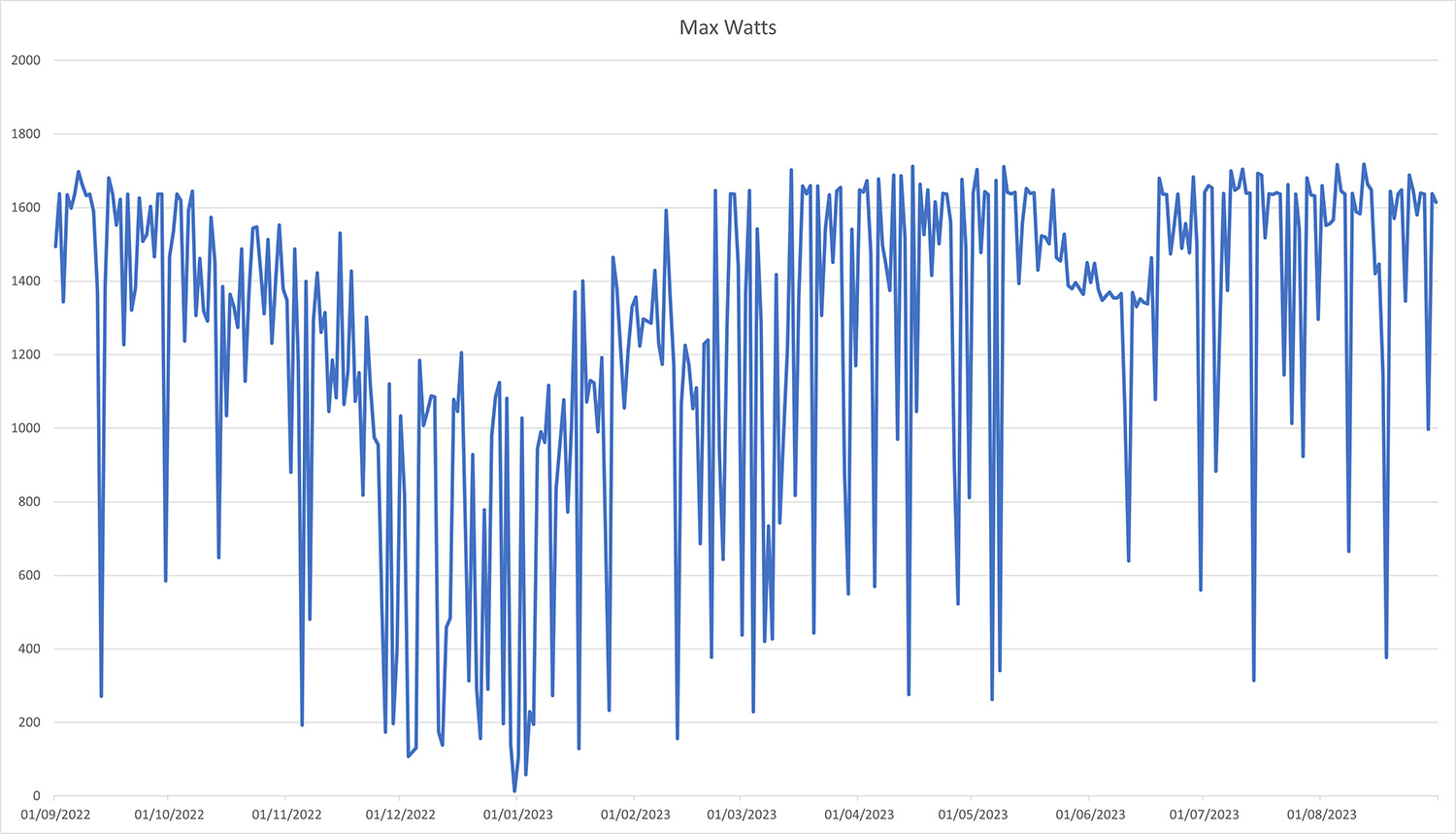It has now been 14 months since we upgraded our Solar PV system with the 1.6Kw array and 1.5Kw inverter.
All the solar data below is from our long-term home logging website at home.briandorey.com, and the solar PV generation page is at home.briandorey.com/meter/solarpvgenerated.

Monthly Solar PV Generation in kWh
| Date | kWh generated | Hours of sunshine * | Savings in Pounds |
|---|---|---|---|
| September 2022 | 194.5 | 128.5 | £79.80 |
| October 2022 | 164.8 | 114.0 | £61.61 |
| November 2022 | 70.7 | 90.0 | £29.00 |
| December 2022 | 41.3 | 56.3 | £16.94 |
| January 2023 | 61.4 | 79.9 | £25.19 |
| February 2023 | 99.3 | 82.9 | £40.74 |
| March 2023 | 116.7 | 52.3 | £41.88 |
| April 2023 | 250.1 | 160.4 | £102.61 |
| May 2023 | 288.6 | 249.6 | £118.41 |
| June 2023 | 288.4 | 294.1 | £188.33 |
| July 2023 | 259.8 | 153.9 | £106.59 |
| August 2023 | 229.2 | 153.1 | £91.04 |
| Total | 2064.8 kWh | 1615 hours | £847.18 |

* Hours of sunshine data from Hurn Airport approx. 20km (12.8 miles) from us and supplied by the Met Office metoffice.gov.uk
Energy Costs
Our energy costs greatly increased in 2023, with electricity being charged at 41.03 p/kWh. Based on these figures the solar PV system has saved us £847.18 in the past 12 months.
In the blog post showing the upgrade from July 2022, I estimated that we could have an annual saving of £1122 per year, so this was lower than expected savings, but the past two months have been more cloudy and wet than the data from the previous year.
The average daily generation was 6.06 kWh, with the highest day recording 11.1 kWh and the lowest day of only 0.1 kWh.
The generation for August 2022 was 13.4% higher than August 2023. This was due to August this year being very wet and cloudy compared to the previous year.
Our energy prices charged by our supplier reduced for the 1st September 2023 to 30.05 p/kWh from 41.03 p/kWh for electricity and gas, going down to 7.55 p/kWh from 10.52 p/kWh.
Electricity Usage Changes
Since the solar PV upgrade, our average daily electric usage from the mains grid has dropped from around 450kWh to 250kWh monthly.
This has been achieved by the increased energy supplied by the solar panels and more changes to our energy usage, such as only using the tumble dryer when there is enough solar energy to power it fully and changing the washing machine to use a 30°C wash cycle instead of 40°C which reduces heating times. Our work computers are now lower powered Dell Micro systems and Mac Minis which have much lower power consumption than the old full tower desktop systems.
You can view historic meter reading data on home.briandorey.com/meter/year, which shows annual energy consumption going back to 2008.
myenergi eddi solar power diverter savings
We installed the myenergi eddi solar power diverter at the end of August 2022 and added data logging into the website starting from the 10th of October 2022. In the winter months, this only diverted a small amount of energy into the hot water, but in the spring and summer, this was enough to heat the water to 50°C on the best days and over 35°C on most afternoons.
The average daily energy diverted was 2 kWh, with the highest day of 4.39 kWh and the lowest day of only 0.01 kWh. The total electricity diverted since the eddi was installed was 405kWh, which would have cost £166.17 if we had used electric heating for the water.
This gave us a more significant saving than expected with our gas usage in the summer months as the boiler does not need to run as long to heat the water for showers, etc.
Maximum Solar PV Watts data
With the 1.6kw solar array and 1.5kw inverter we expected the maximum power generated to be 1500 watts but the inverter regularly outputs 1670 watts on sunny days and sometimes peaks at 1700 watts. During the summer months this peak value is normally between 1500 and 1600 watts and between November and January this drops to around 1100 watts.
The chart below shows the maximum generated watts for each day for the past year.

Future Upgrade options
We currently have 5 solar panels on the south facing side of our roof. On the back of the house is a north facing roof with windows and an area of west facing slate roof which is a possible location for additional solar panels.
We estimate that we could install an additional 2kw of solar panels in this area which receives a lot of sunlight after midday and into the early evenings in the summer months but only a small amount in the winter months at the end of the roof.
The panels would also need individual optimizers as different parts of the roof are shaded during the day adding to the cost.
The rear of the house is 3 stories high so scaffolding costs would also be another consideration and when we previously had the roof replaced, the cost for the scaffolding was over £1500.
We would also need to buy another inverter and find space in our crowded shed to install it.
The extra energy generated would currently go into the myenergi eddi diverter to the hot water but based on current usage this would result in wasted energy in the afternoon which would be fed back into the grid.
Battery systems and Heat Pump option
A workaround would be to install a battery system, but these are currently expensive and would require most of the houses wiring and power distribution to be moved to allow the battery and inverter system to be fitted into the basement shed rather than the fuse box which is currently located at the front of the house.
Based on current prices, the cost to have additional solar panels fitted and a battery system would be between £6,000 and £10,000 plus the cost of moving all the household wiring.
The Gas boiler currently in the basement shed would also need to be moved or replaced. With the plans to phase out gas boilers in the UK, this would be the time to upgrade to a heat pump system, but this would also need the entire houses plumbing to be upgraded to larger pipe sizes and the hot water cylinder moved to the basement and the removal of the current water tanks in the roof space.
This would be hugely expensive and disruptive with Air source heat pumps typically costing between £7,000 and £10,000 to buy and have professionally installed and the additional cost for the plumbing changes.
Based on the above prices we are going to wait for the costs of heat pumps to come down and for solid state batteries to reduce in price and have higher capacity and lifespans.
Overall we think it will be much more cost effective for us to replace the double-glazing windows with higher efficiency triple glazed windows and add additional insulation to the external walls to reduce our heating costs.

Comments